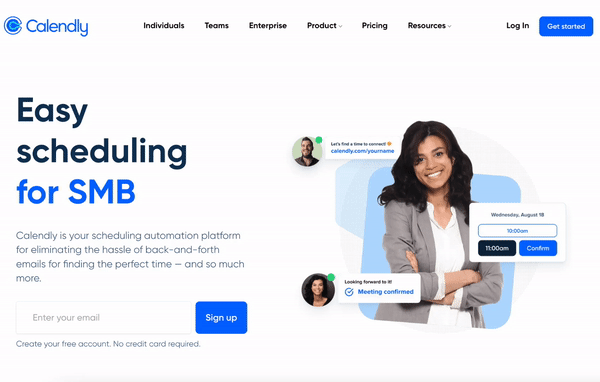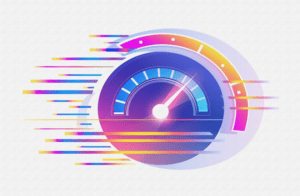Tracking website conversions is essential. By tracking conversions on your website, your marketing team can see how effective all of your campaigns are. If you don’t track conversions, your marketing is often done blindly. As a result, it can be difficult to improve. That’s exactly why we have put together this article to help you track website conversions! First, let’s go over what types of conversions you might want to track.
Figuring Out What Types of Website Conversions You Want to Track
As a B2B company, it’s a little harder to track website conversions than it is for B2C. That’s because, with B2C companies, conversions often equate to purchasing something on the website. But, this isn’t always the case for B2B companies. Here are a few of the most popular website conversions that B2B companies should be tracking.
Booking a Demo
If you are a B2B software as a service company, then booking a demo is one of the best website conversions that you can track. This can help you track how many people are actually signing up for the demo, how many are attending the demo, and what percent of demo attendees are converting into paying customers. In addition, it can help you see how these users flow throughout your website before booking a demo. As an example, you can find out how many visits it takes before the average prospect books a demo.
Starting a Free Trial
Starting a free trial is arguably the most important website conversion that you should be tracking. By tracking your free trial sign-ups, you can compare how many are starting trials, and how many are turning into paying customers. You can use this to see how your most qualified visitors are being acquired. And, just like booking a demo, you can see how many visits it takes before each prospect takes before they start a trial.

Request Pricing
If your company uses a gated pricing model, then tracking how many users are requesting a quote or pricing breakdown can be a great conversion to understand. It can be helpful to compare how many visitors are requesting pricing versus how many are actually converting. This may be able to help you adjust your pricing in the future. Or, you can use an email sequence to offer a discount on their subscription if they do not convert.
Filling Out Website Forms
If you have forms on your website, it’s very helpful to track how many are submitting the form. Contact us, gated content, or quizzes are all examples of forms that your company can take advantage of. You can then see how they were acquired, and use this to your advantage. As an example, if you see that your visitors that are acquired through LinkedIn ads are more likely to contact your company, you can optimize your LinkedIn landing pages with a contact us CTA.
Best Software to Help You Track Website Conversions
There are some website conversions that you can track manually, although it is very difficult to do so. With the help of a software, you can take your marketing and lead generation efforts to the next level. Here are our top 3 favorite software to use.
Google Analytics
With over 28 million users, Google Analytics is the most popular website analytics tool. And, of course, it can be used to track your website conversions. There are a few different ways that conversions can be tracked with Google Analytics. The first, and easiest way is by tracking a specific page viewed. This could be a thank you, request received, or similar page that appears when an action is completed. Below is an example of how we have set up a page view goal for visitors that sign up for our newsletter.
Another way that you can track goals in Google Analytics is to track specific actions or events taken on your website. This could include button clicks or video plays. So, if booking a demo doesn’t take the visitor to a new page, you could track the “Book Now” button clicks instead. Below is an example of an event conversion.
The negative thing about tracking conversions with Google Analytics is that you have no idea who is converting. That’s where our next software can help.
Visitor Queue
The next software that you can use to track website conversions is Visitor Queue. Visitor Queue is a website visitor identification software that can identify your anonymous website visitors. We provide information about the companies that land on your website, including a company overview, links to their social channels, how many employees they have, and more. Additionally, we provide employee contact information including email addresses, phone numbers, and LinkedIn channels to help you reach out.
Recently, we have introduced the ability to track website conversions. The same ways that you can track website conversions in Google Analytics can be done in Visitor Queue. But, you can see the companies that are completing these conversions. This can help you during your sales cycle, and stay one step ahead of your prospects. Visitor Queue can also integrate with your Google Analytics account so you can get even more information about the companies on your website. Start your 14-day free trial of Visitor Queue today and stop losing leads.
Hotjar
Hotjar is a heatmap and session recording software that will provide you with an overview of what people engage with the most on your website. Of course, you can view your heatmaps to see how many clicks certain aspects of your website are getting.
You can also use Hotjar to track events within your recordings. When you implement events, you can trigger specific recordings, trigger a survey to appear, or filter your recorded sessions so you only view sessions that have this event take place. To learn more about Hotjar event tracking, here is their support article explaining how to implement it.
How to Improve Your Website Conversion Rate
Now that you know how to track website conversions, you may be asking yourself, “How can I get more website conversions?”. That’s the question of the century! If you are trying to get more website conversions, here are a few tips and tricks that might be able to help.
Improve Your UI/UX
One of the best ways to improve your website conversion rate is to improve your user interface and user experience. This essentially means making your website easier and more aesthetic to navigate. This will encourage users to flow through your website seamlessly. A regular website redesign or update can help improve your UI and UX exponentially, which can result in an increase in website conversions.
Switch Up Your CTAs
There’s not always a one-size-fits-all approach to a website call to action, or CTA. And you’d be surprised at how such a small change can improve your conversion rate. If you’re not sure what CTA will work best on your website, it can be helpful to experiment with A/B testing. This means that you try one option, like “Start Trial” for 4 weeks. And then switch the CTA to say “Try For Free” for the following 4 weeks. You might see that one of the calls to action drives more trial signups than the other.
Generate Higher-Quality Traffic
If you have a lot of website visitors but are not getting a lot of conversions, then you might be attracting traffic that is high enough quality or relevant to your offerings. You’ll want to look at how your visitors are being acquired, and see what marketing channel has the highest bounce rate and a low conversion rate. This can help you see what marketing tactics might not be working. Adjust your campaign, and see if that helps in a few weeks.
Website Personalization
When you are scrolling through Amazon looking for a new dog collar, you may notice that dog toys, dog bowls, or other dog accessories might start popping up. This is website personalization. Amazon is doing this in hopes that you will purchase other dog-related products. B2C companies have been using website personalization for years, but this technology is relatively new for B2B companies. By personalizing your website, you show your website visitors a custom view of your website tailored to their specific needs. Remember Visitor Queue from earlier? We also offer a website personalization feature! So, you can target your website visitors based on their industry, company size, or even company name! By showing your visitors exactly what they are looking for, you can decrease your bounce rate and increase website conversions.

Setting Goals
You should always be looking at how you can improve your marketing initiatives to drive more website conversions. By tracking your conversions, you should know what is driving your highest-quality traffic. Your marketing team should continuously be setting goals on how you can improve your conversion rate. Setting goals will help your team see where they can improve, develop new initiatives, and better understand your funnel.
Closing Statements
Tracking website conversions should be an essential part of your marketing strategy. It will help you see what is working, and what might need to be improved on. Without tracking conversions, you’re only getting half of the story. And, there are a number of ways that you can track these conversions. If you have any questions about Visitor Queue, don’t hesitate to reach out.
 Identify
Identify Personalize
Personalize Benchmark
Benchmark Agencies
Agencies Integrations
Integrations Case Studies
Case Studies Use Cases
Use Cases Blog
Blog Resources
Resources









